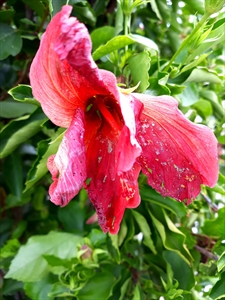- Narrow distribution. Probably native of Fiji. Hosts are hibiscus, and members of the myrtle family, including Eucalyptus, Melaleuca, and Eugenia.
- Damage done by adults chewing the flowers.
- Eggs coated with faeces drop to the ground. Larvae take very long time to emerge; they live in a case of their own faeces, are nocturnal and feed on dead leaves and bark, but maybe part-time on living plants. Adults with brown head and black forewings. Often seen 'male-gating' (male on female preventing access to others).
- Cultural control: hand-pick, checking both night and day.
- Chemical control: unlikely to be needed, but if they are try biorational first: neem, pyrethrum or chilli.
Pacific Pests, Pathogens and Weeds - Online edition
Pacific Pests, Pathogens, Weeds & Pesticides
Hibiscus flower-eating beetle (400)
Click/tap on images to enlarge
Summary
Common Name
Hibiscus flower-eating beetle
Scientific Name
Genus and species unknown. A chrysomelid beetle of the subfamily Cryptocephalinae.
AUTHOR Grahame Jackson & Mani Mua
Information from Chris Reid (pers.com), Australian Museum, Sydney.
Produced with support from the Australian Centre for International Agricultural Research under project HORT/2016/18: Responding to emerging pest and disease threats to horticulture in the Pacific islands, implemented by the University of Queensland and the Pacific Community






